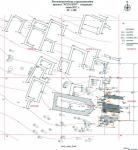Summary (English)
HOTALICH FORTRESS (Nadezhda Boteva – nadejda_boteva@abv.bg) The explorations of the Christian cemetery around Church No. 3 in the eastern part of the town, continued. During the last two seasons 42 graves were explored. The funerary pits were surrounded with stones. Some of the graves were dug out along the northern or the southern sides of the rooms of the buildings that were already abandoned. Most burials belonged to adults who were placed in wooden coffins. The small children and babies were not buried in wooden coffins, but most of them were laid in burial chambers built of stone slabs. Grave No. 28 situated at 2 m in front of the apse of the church, deserves special attention. A man was buried there, laid in a wooden coffin. Three coins of the first half of the 13th century were found close to the left hand. A lead plaque was found in the grave, showing the images of Apostles Peter and Paul, with a Latin inscription that reads: +SIGNA APOSTO/LORVM PET/RI ET PAV/LI (Sign of Apostles Peter and Paul). This type of lead plaques was produced in Basilica San Pietro in Rome after AD 1199. The lead plaque indicated that the dead man made a pilgrimage to Rome. A girl was buried in Grave No. 22. The grave goods included one glass and five bronze bracelets, a pair of silver earrings and a necklace consisting of 12.000 – 13.000 black glass beads, 2000 – 2500 red glass beads, 15 beads of rock crystal and 16 beads of carnelian. A young woman was buried in Grave No. 36. Four bronze bracelets were discovered on her arms and a necklace on her chest, consisting of c. 10.000 black glass beads and a large blue bead. A small iron cross was found on her left shoulder and a pair of silver earrings on both sides of the skull. The cemetery functioned during the second half of the 13th century and was situated over the destroyed houses of the end of the 12th – beginning of the 13th centuries.
- Nadezhda Boteva - Museum of History – Sevlievo
Director
Team
Research Body
- Museum of History – Sevlievo






![Download [PDF]](/excavation/skins/fasti/images/results/download_sml.png)
